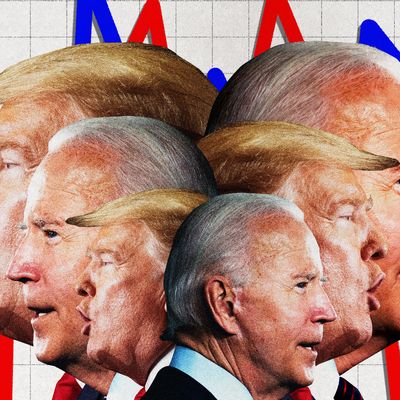
Six days out from November 3, Joe Biden is by any objective measurement still maintaining a sizable lead over Donald Trump in both national and battleground-state polling averages. Yes, you can cherry-pick data (especially from the consistently partisan and methodologically challenged Rasmussen and Trafalgar Group outlets) showing Trump confidently steaming toward victory, and more credible pollsters differ on the size of the gap the president must close in what has been a much steadier public-opinion climate than the one we saw in 2016.
But what we may be beginning to see is one of the rare circumstances when “real life” — i.e., external events — is having an impact even in a highly polarized electorate with relatively fixed views of the two major-party candidates. At present, Trump is proclaiming a personal and national victory over COVID-19, or at least suggesting a nonchalant attitude, as Politico reports:
With one week left in the election, President Donald Trump is perfecting his closing argument about the pandemic gripping much of the nation: Don’t worry about it.
In rally after rally, tweet after tweet, Trump is encouraging his supporters and everyone else to stop talking about the coronavirus. His key message: It’s not that big of a deal, vaccines are on the way, and if people get sick, most of them will survive it just as Trump and his family did.
Unfortunately for Trump, this messaging is colliding with a growing national comeback of the pandemic, which is particularly sharp in some inconvenient places — most notably superhot spot Wisconsin. That’s why a new survey of the Badger State for the highly regarded ABC-Washington Post polling outfit has people wondering if COVID-19 is about to inflict a final defeat on Trump. FiveThirtyEight’s Nathaniel Rakich explains:
Once in a blue moon, you see a poll that makes you blink twice to make sure you’re not seeing things. This morning’s ABC News/The Washington Post survey of Wisconsin was just such a poll. It showed Joe Biden 17 points (not a typo) ahead of President Trump, 57 percent to 40 percent, among likely voters. To put it mildly, this is a stunning margin in what is supposed to be one of the most competitive swing states in the country — a place that Trump carried by less than one percentage point in 2016.
The margin shown in this poll is certainly an outlier; this very day the Marquette Law School survey team, another well-regarded pollster (though not as well regarded as ABC-WaPo), showed Biden up by five points among likely voters in Wisconsin in data collected at the same time. But you have to wonder if COVID-19 is creating a trend that is pushing Biden’s lead up, not just in Wisconsin but across the upper Midwest, as Rakich notes:
Much of Wisconsin is currently a hot spot; on Tuesday, the state reported more new cases (5,262) and deaths (64) than any other day of the pandemic. The same day, Iowa and Minnesota announced a record number of hospitalizations, and cases are on the rise in Michigan as well.
The ABC-WaPo poll of Wisconsin shows that Trump’s net negative job-approval rating on handling the pandemic has doubled since mid-September; he’s now underwater by 20 points at a time when COVID is the main topic of news in the state (not least because an outbreak has hit the nationally ranked Wisconsin Badgers football team, canceling its game this weekend with bitter rival Nebraska). Even if this particular poll is exaggerating the trend, it’s one that needs to be moving in the opposite direction for Trump.
Another big problem for the president is illustrated in some beneath-the-top -line polling analysis from The Wall Street Journal and NBC:
About 13% of voters in Wisconsin, Florida and Pennsylvania settled on their candidate choice in the week before the last election, a report by a professional association of opinion researchers found. Those voters broke for Mr. Trump by 30 percentage points in Wisconsin and by 17 points in Florida and Pennsylvania, helping to deliver narrow victories, the study said.
This month, the Journal/NBC News poll went looking for signs of a similar late shift — and found a different picture than in 2016. Undecided voters seem to be moving equally toward both presidential candidates …
The survey found that many of these voters had picked a candidate in recent months, as the share who were uncommitted fell from 31% to 18%. And they moved almost equally to Mr. Trump and to his challenger, former Vice-President Joe Biden. Overall, this set of voters favored Mr. Biden more than the president.
Late deciders also tend to pay attention to the news in front of their noses — another reason the COVID-19 resurgence is bad news for the incumbent.
If we look at the big picture, Biden’s lead currently stands at 8.6 percent in the FiveThirtyEight polling averages and 7.1 percent at RealClearPolitics. That’s down from a week ago but still pretty sizable. At this point in 2016, Clinton’s lead at RCP was 1.3 percent. Using FiveThirtyEight’s averages for state polls, Biden currently leads in eight states Trump carried in 2016, representing 123 of his 304 electoral votes: Arizona (3 percent), Florida (1.4 percent), Georgia (1.4 percent), Iowa (1.5 percent), Michigan (8 percent), North Carolina (2.1 percent), Pennsylvania (5.1 percent), and Wisconsin (8.4 percent). Trump doesn’t lead in any of the states Clinton won. Yes, Biden’s margins are small in some of these states, but as an experiment let’s award the president a large, uniform swing of 4 percent in the vote. That would tilt a bunch of states to him, but Biden would still win thanks to a sweep of the very three Rust Belt states that produced Trump’s 2016 upset — states where “real life” is becoming a problem for the incumbent.
Meanwhile, in Senate polling, there remain plenty of close races, but new polls tilt toward good news for Democrats. In Michigan, where Republicans really need an upset of Democratic incumbent Gary Peters by John James, two new high-quality polls of likely voters show Peters maintaining or extending his lead. New York Times/Siena has Peters up 49-41, and ABC/WaPo has a slightly smaller (but incumbent-majority) 52-46 Peters lead. You would have to assume that if Trump is hurt by a COVID-19 surge in and near the state, his ticket mate might suffer as well.
Two southern Senate races remain very close, but in North Carolina, a Republican-sponsored Civitas/Harper survey shows Cal Cunningham narrowly hanging on to a 46-43 lead over Republican incumbent Thom Tillis. And in Georgia, a poll from gold-standard Monmouth has Jon Ossoff leading Republican incumbent David Perdue 49-47 in a state where a January runoff will be held if neither candidate wins a majority.
Finally, data from the underpolled Maine race between incumbent Republican Susan Collins and Democratic challenger Sarah Gideon shows the Democrat maintaining what has become a steady, if narrow, advantage. A Colby College survey of likely voters has Gideon leading 47-43. Maine’s ranked-choice voting system requires a majority vote for victory, either before or after an “instant runoff” with second choice distributed. Right now, Colby has Gideon and Collins tied in second-choice preferences.
Six days isn’t a lot of time for big changes in the contests that aren’t close, although there is a lot we still don’t know about turnout patterns given the big partisan split between Democrats voting by mail and Republicans voting in person. But the pandemic marches on at a very bad time for a Republican Party harnessed to a president who wants voters to think about everything else.






























